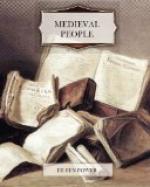his eyes to where the last rays of sun slanted on
to the lichened roof of the great tithebarn, and on
to the rows of tenants, carrying their sheaves of corn
along the road; and he reflected, perhaps, that John
Mann and Thomas Spooner, his own tenants, were good,
steady friends, and that it was well to leave them
a gown or a pound when he died. Often also, in
his last year or two, he must have sat with his wife
in his garden with the dove-house and watched the
white pigeons circling round the apple-trees, and
smiled upon her bed of flowers. And in winter
evenings sometimes he would take his furred cloak
and stroll to the Dragon Inn, and Edward Aylward,
mine host, would welcome him with bows; and so he would
sit and drink a tankard of sack with his neighbours,
very slow and dignified, as befitted the greatest
clothier of the town, and looking benevolently upon
the company. But at times he would frown, if he
saw a truant monk from the abbey stolen out for a
drink in spite of all the prohibitions of bishop and
abbot, shaking his head, perhaps, and complaining that
religion was not what it had been in the good old days;
but not meaning much of it, as his will shows, and
never dreaming that twenty years after his death abbot
and monks would be scattered and the King’s
servants would be selling at auction the lead from
off the roof of Coggeshall Abbey; never dreaming that
after four hundred years his house would still stand,
mellow and lovely, with its carved ceiling and its
proud merchant’s mark, when the abbey church
was only a shadow on the surface of a field in hot
weather and all the abbey buildings were shrunk to
one ruined ambulatory, ignobly sheltering blue Essex
hay wagons from the rain.
So Thomas Paycocke’s days drew to a close amid
the peace and beauty of the most English of counties,
’fatt, frutefull and full of profitable thinges,’[15]
whose little rolling hills, wych elms, and huge clouded
skies Constable loved to paint. There came a day
in September when gloom hung over the streets of Coggeshall,
when the spinning-wheels were silent in the cottages,
and spinners and weavers stood in anxious groups outside
the beautiful house in West Street; for upstairs in
his bridal chamber, under its noble ceiling, the great
clothier lay dying, and his wife wept by his bedside,
knowing that he would never see his child. A
few days later the cottages were deserted again, and
a concourse of weeping people followed Thomas Paycocke
to his last rest. The ceremony of his burial
befitted his dignity: it comprised services, not
only on burial day itself, but on the seventh day
after it, and then again after a month had passed.
It is given best in the words of his will, for Thomas
Paycocke followed the custom of his time, in giving
his executors elaborate injunctions for his funeral
rites: ’I will myne executors bestowe vpon
my buryng daye, vij day and mounthe daye after this
manner: At my buriall to have a tryntall of prests
and to be at dirige, lawdis, and comendacons as many




